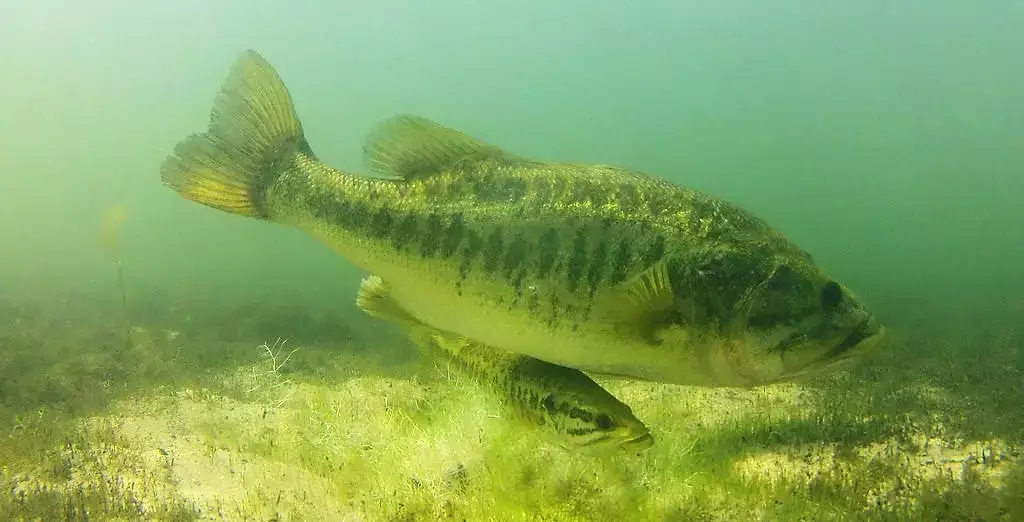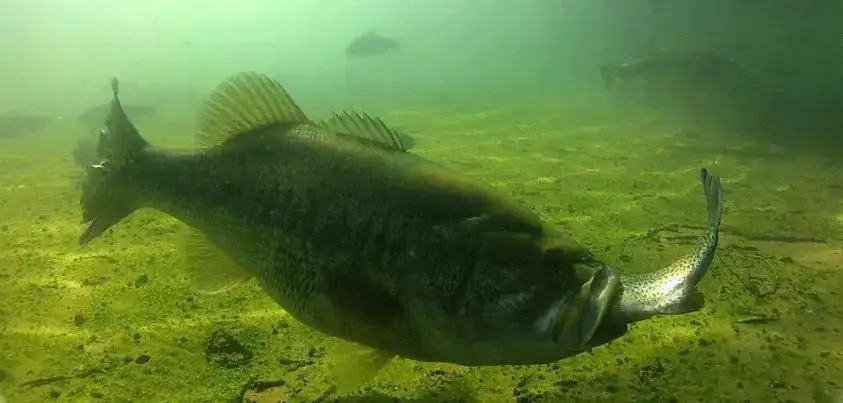Do you like to fish? If so, you’re probably curious about how often do bass eat. Bass are a popular sport fish found in many waterways across the country.
They are predatory fish, which means they primarily feed on other fish. In this blog post, we will take a closer look at bass feeding habits and provide some tips on successfully catching them.
Do Bass Feed Every Day?
The short answer to this question is yes, bass feed every day. However, their feeding habits can vary depending on the time of year and the water temperature.
In general, bass will feed most actively early in the morning and late in the evening. However, they will usually take a break from feeding to conserve energy during the middle of the day.
Do Bass Eat Other Fish?

Yes, bass eats other fish. This is how they get most of their food. This means that you’ll want to use lures that mimic the appearance and movement of smaller fish to catch them more effectively.
Bass are opportunistic feeders, which means that if something edible comes within reach, they will eat it.
What Does Bass Eat When They’re Hungry?
Bass are not picky when it comes to food, which is why you can find them in a wide range of waterways.
They have been known to eat insects and even mice if there’s nothing else available. This makes live bait such as worms and minnows a good choice when fishing for bass.
When Do Bass Stop Feeding?
As we mentioned earlier, bass will usually stop feeding during the middle of the day. Again, this is because the water temperature can affect their metabolism and how active they are.
In general, bass feeds more actively when the water temperature is warmer and less active when the water temperature is cooler.
How Often Do Bass Eat
It’s no secret that bass are opportunistic feeders. This means they’ll take advantage of any food source that comes their way.
However, this doesn’t mean bass are constantly hunting for food. Instead, they’re selective creatures who will actively seek out food sources that are easy and convenient to find.
Largemouth bass consumes around a third of their body weight each day. This 1/3 could be made up of another bass 1/3 the size of the one that just ate it, but crayfish, little fish, frogs, eels, and other organisms that live in its habitat are typically eaten by bass.
Bass typically feed when there’s adequate light outside. This means you’ll have the most success catching bass before sunrise or after sunset (when it’s dusk).
However, this doesn’t mean you won’t catch any fish in the middle of the day. There are always bass lurking around, waiting to strike a lure.
Bass feed on both live and dead bait. They’ll eat anything from insects and small fish to frogs, rodents, and even snakes.
When fishing for bass, it’s important to use a variety of lures that resemble different types of prey. This will help entice more fish to strike your lure.
When fishing in rivers and streams, bass tends to feed on small baitfish like minnows or shad.
They also eat insects that fall into the water from above. This means you should use a variety of lures that resemble these types of food sources when casting near flowing bodies of water.
In lakes and reservoirs, bass feed on a wide variety of prey items. They’ll eat crawfish, insects, leeches, frogs, and even large fish.
Because there are so many different food sources in these types of waters, it’s important to use a variety of lures that resemble different types of prey.
How Often Do Bass Feed in the Summer?
Bass feed more often in the summer because this coincides with their spawning season, which means they need to eat as much food as possible. This makes it easier for anglers who want to catch them.
How Often Do Bass Feed in The Winter?
Bass feed less often in the winter because this coincides with their hibernation period. This means they will only eat when necessary for survival purposes, such as finding shelter from cold temperatures or escaping predators.
If you want to catch some bass during this time of year, try using lures that imitate smaller fish like minnows or shad.
How Often Do Bass Feed in The Fall and Spring?
Bass feed less often in the fall and spring since their spawning season is over then, so they don’t need as much food to survive anymore.
This makes it more difficult for anglers who want to catch them. However, if you use lures that imitate smaller fish like minnows or shad, then they’ll still have a chance of getting caught.
What Does a Big-Mouthed Bass Eat?

Largemouth bass are opportunistic feeders, meaning they will eat whatever is available in the environment. But how often do largemouth bass eat?
They eat every day when they have access to food sources, but how much and how often a largemouth bass eats depends on how big it is, what kind of fish it is (carnivorous or herbivorous), and how much food is available.
Some bass will eat almost anything that fits in their mouth, from small fish to frogs, crayfish, insects, and even water snakes.
But most of the time, largemouth bass prefer to eat smaller fish—especially when they are young. Then, as bass age, they eat larger prey such as crayfish and frogs.
If you’re wondering how often largemouth bass eat when the food is plentiful, an adult can eat up to six meals per day or more if necessary.
A hungry smallmouth may consume upwards of ten times its body weight in a year – that’s a lot of food.
Does Bigmouth Bass Have Teeth?
There are three species of bass that most anglers target in North America: largemouth, smallmouth, and spotted. Largemouth and smallmouth have teeth on their jaws only; spotted bass does not.
These fish do not chew their food as we do with our big flat molars. Instead, they use those sharp teeth to hold prey while they swallow it whole.
The teeth are hard to see, and they’re often mistaken for gill plates by inexperienced anglers.
The bigmouth bass has several rows of “teeth” found on their tongue, upper jaw (maxilla), and lower jaw (mandible). They also have a pharyngeal tooth in their throat to crush prey items.
Bass are predators that feed on a variety of live and dead organisms. They consume mostly fish and crayfish, aquatic insects, frogs, salamanders, snakes, small mammals, and birds. Bass will eat anything they can fit into their mouths.
Does Largemouth Bass Eat Their Babies?
In general, bass eats their babies when they’re stressed out because of a lack of oxygen.
For instance, if you stock your pond with too many fish, there’s not enough space for the adults to eat or breathe. The lack of oxygen causes the fish to stress out, and that’s how they end up eating their eggs.
If there are too many fishes in your pond, you can remove some or add more water to dilute the concentration. By doing so, you will solve this problem immediately.
How Long Can a Bass Live Without Food?
This is a difficult question to answer as it depends on various factors, such as the age and size of the bass, how much they’ve eaten recently, and what type of prey is available. Generally speaking. However, bass can go without eating for several days if necessary.
Some anglers intentionally deprive their bass of food to become more aggressive during fishing tournaments.
Bass are constantly eating, but they don’t always need to eat a lot to survive. Bass can go for several days without food if necessary.
Bass are opportunistic feeders and will eat whatever is available to them. This can include small fish, crayfish, insects, frogs, and even aquatic plants.
Bass fishermen need to be aware that bass can become conditioned to certain lures and will only bite at those lures.
This is why it’s important to change your lure selection from time to time.
Bass are constantly eating, but they don’t always need to eat a lot to survive. Bass can go for several days without food if necessary. However, Bass are opportunistic feeders and will eat whatever is available.
How Many Times a Day Should I Feed My Fish?
This is a question that many fish owners have, and the answer can vary depending on the type of fish. For example, how often they eat typically depends on their age and size.
Juvenile bass will need to be fed more frequently than adult bass, as they constantly grow and require more energy. Similarly, larger bass requires less food since they have a larger body mass.
In general, bass should be fed twice a day. This will ensure that they get the nutrients they need while maintaining a healthy diet.
If you notice your bass isn’t eating as much as usual, try reducing their food intake to once per day. On the other hand, if your fish eat too much, it might be time to increase how often you feed them.
Conclusion
Bass are voracious eaters and will consume a variety of prey items. They typically feed several times per day, but their feeding habits vary depending on the season and water temperature.
Bass are opportunistic predators and will take advantage of any easy meal they can find. Anglers can use this to their advantage by using lures that imitate natural prey items.
By understanding how often bass eats, anglers can better target these fish and increase their chances of catching them.

